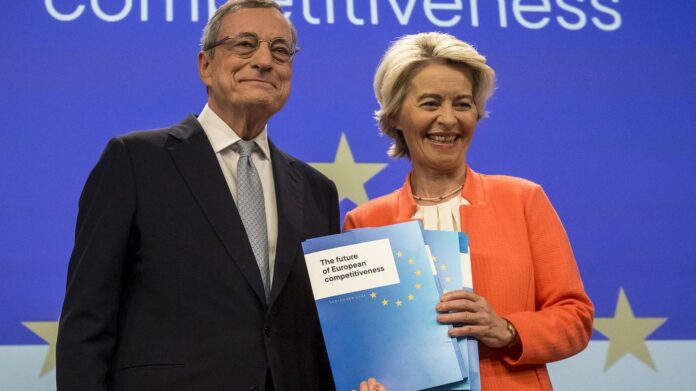
Is Europe facing a challenge similar to the reconstruction after the end of the Second World War? At least that seems to be how the former head of the European Central Bank (ECB), Mario Draghi, sees it. The report on European competitiveness, which Draghi prepared on behalf of the EU Commissiondemands nothing less than reforms and investments on a historic scale: the EU should raise 750 to 800 billion euros annually to become more productive and thus competitive again. That is around five percent of the EU’s gross domestic product.
By comparison, the Marshall Plan, which the USA launched to promote the reconstruction of the EU after the Second World War, amounted to one to two percent of European GDP.
The investments should go into important joint projects, such as the expansion of the energy network or defense, the report says. Europe is facing an “existential challenge.” The EU is in danger of being left behind by the USA and China. The American economy is growing faster than the European one. This is mainly due to weaker productivity in the EU states.
Inaction threatens Europe’s prosperity, environment and freedom
If Europe does not succeed in becoming more productive, it will not be able to “become a leader in new technologies, a beacon of climate responsibility and an independent actor on the world stage at the same time.” The European social model could also no longer be financed. In a guest article in the “Economist” Draghi was even clearer. If the EU does not act, it will have to sacrifice either its prosperity, its environment or its freedom
According to Draghi’s strategy report, record investments are necessary to avert this fate. And to manage these, new “common sources” may be necessary, it says succinctly. But that is not what is meant by this. as common European debtEvil tongues might now claim that Mario Draghi is simply continuing where he left off as President of the European Central Bank in 2019.
When the national debt of many European countries grew rapidly after the outbreak of the global financial crisis in 2009 and speculators bet on an end to the monetary union, the then ECB president Draghi calmed the financial markets with the famous statement that the ECB would do “whatever it takes to save the euro.”whatever is necessary(“Whatever it takes”). If necessary, the ECB would buy up the respective government bonds of the faltering countries. Draghi’s promises and aid programs worth billions kept the monetary union alive. For critics, this was the beginning of an illegal pooling of European government debt.
Negative reactions to Draghi’s proposals were not long in coming. Finance Minister Lindner rejected Draghi’s proposal for joint debt: “The mutualisation of risks and liability creates democratic and fiscal problems,” said Lindner. “Germany will not agree to this.” Joint debt is not only a red flag in this country. The governments in the Netherlands, Austria and Finland also reject the concept.
The alternative of increasing EU membership contributions instead of joint debt is also likely to be met with widespread rejection. As right-wing populist and right-wing extremist parties are gaining strength not only in Germany but also throughout Europe, who want to push back or even end the European projectmany European governments will not be enthusiastic about it either.
It’s about more than debt
Nevertheless, politicians in Brussels and Berlin would do well not to reduce Draghi’s report to just calls for more debt. The report It is not only a (well-intentioned) accurate but also ruthless analysis of Europe’s economic situation. It lists a number of structural reforms that the EU urgently needs to implement. For example, the report criticizes the fact that EU states are wasting common resources in important areas: in defense policy, where member states should coordinate their weapons systems to save costs.
The EU also needs to coordinate better when it comes to decarbonization. In order to reduce energy prices, “all available solutions” are needed. This also includes nuclear power and CO₂ capture as well as faster approvals for power plants and networks. In order to manage the necessary investments, the report also proposes deepening the capital markets union. This could also mobilize private funds.
And there is another important suggestion in the Draghi report: It recommends expanding the so-called qualified majority decision, in which a decision does not require an absolute majority of member states to vote in favor, to more areas. As a last resort, like-minded countries should also be allowed to go their own way if necessary. That is right, because the EU’s decision-making structures have not grown to keep up with the challenges.
The EU must finally reform its structures
What all these proposals have in common is that they address the structures in order to create better economic conditions. They can also be implemented without taking on new debt. The fact that better investment conditions can also be achieved through tax incentives has recently been the American Inflation Reduction Act (IRA) of President Joe Biden’s administration. Companies that invest in green technologies are rewarded with tax breaks.
Instead of a triad of coordinated industrial policy, faster decision-making processes and massive investments, a lot would be achieved if the European Union could agree on a two-pronged approach of structural reforms and better coordination.
Many of the points mentioned in the Draghi report are not new. The EU should finally implement them.
